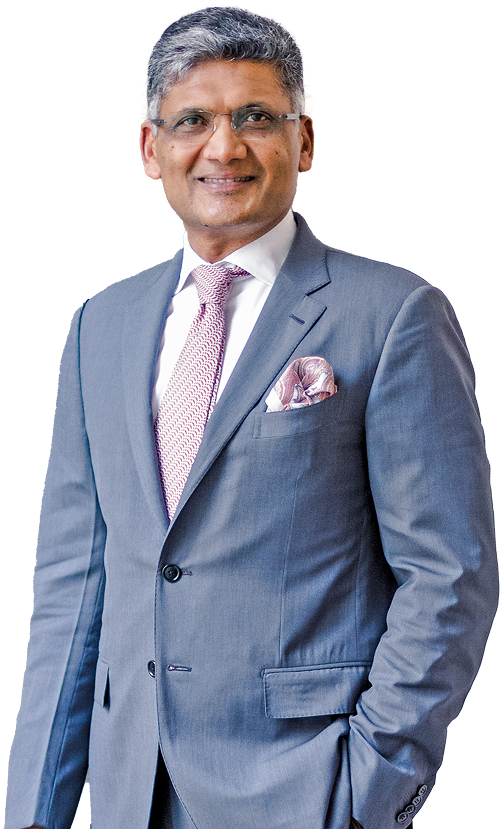The global and the local
The global economic environment over the past year was marked by heightened volatility. Geopolitical tensions, escalated conflicts, level-playing trade policies, and inflationary pressures influenced supply chains, market dynamics, and consumption patterns across the world. These developments reinforced the need for businesses to transcend conventional thinking and embrace agility, perseverance, and long-term vision.
Despite these headwinds, the Indian economy continued to demonstrate remarkable resilience, underpinned by robust domestic demand, a thriving digital ecosystem, an expanding start-up landscape, and the government’s sustained focus on infrastructure development, policy support and investments. India’s GDP grew by 6.5% in FY25, signalling strong economic momentum driven by industrial output, infrastructure expansion, and healthy consumption. I am deeply encouraged by the progress made by our own industry in alignment with the nation’s vision.
As per World Stainless, the global melt production of stainless steel in CY24 was 63 million tonnes (MT), showing a growth of 7% over the previous year. Further, as per published data, stainless steel consumption grew 6% year-on-year to 57 MT in CY24. In India, this percentage was higher than the global average, growing at 8% from 4.5 MT in FY24 to 4.8 MT in FY25. This strong performance has been significantly supported by government-led initiatives that have provided a robust impetus to the industry. Make in India has evolved into a transformative national vision, accelerating indigenous manufacturing and positioning India as a global industrial powerhouse. This vision was further reinforced by the government’s FY25 budget, which allocated INR 11.11 lakh crore towards capital expenditure along with key policy measures, underscoring its focus on infrastructure-led growth and the broader goal of economic self-reliance. Given India’s current economic trajectory and sustained infrastructure investments, stainless steel demand is expected to grow even further, in sync with the GDP over the next decade. Sectors such as railways, infrastructure, logistics, and automotive will continue to drive this demand, given the unique benefits of this wonder metal, such as corrosion resistance, strength, hygiene, and safety, as well as its wide applications. Additionally, the rising focus on emerging strategic sectors such as aerospace, defence, agricultural implements, medical equipment, and green energy will further support stainless steel growth. Even with this upward trend, nearly 30% of domestic consumption in FY25 was met through imports. This was due to the influx of substandard stainless steel imports from China and those rerouted through ASEAN countries, including Vietnam. The Indian industry is fully capable of meeting growing domestic demand, making it imperative to address this gap by ensuring quality standards and progress towards self-reliance. We appreciate the steps taken by the Government of India towards standardisation and quality control, and look forward to such continued decisive actions to safeguard the interests of the domestic industry. Such decisive measures will give confidence to the domestic industry to further enhance investment in downstream and upstream capacities and capabilities.
Value-creation through strategic action
Recognising the critical role of stainless steel in India’s economic growth, all our actions have been guided by a larger purpose: to contribute meaningfully to the nation’s industrial journey. Our aim goes beyond manufacturing at scale for domestic needs; our focus is to elevate stainless steel’s positioning as a category, one that stands at the intersection of national infrastructure, everyday utility, and future readiness. By enabling long-lasting infrastructure and offering high-performance solutions, we endeavour to improve the quality of life for millions of Indians, while deepening our contribution to the nation’s pride and progress.
This vision has translated into tangible outcomes – from supplying cutting-edge stainless steel for the Vande Bharat sleeper train, hailed as a new era of innovation and safety in Indian Railways, to providing customised stainless steel and low-alloy steel sheets for BrahMos Aerospace’s defence projects. Through these initiatives, your company has demonstrated unwavering commitment towards making India atmanirbhar.
In response to the rising demand for stainless steel and our company’s future growth plans, we accelerated strategic investments. Your company signed an MoU with the Government of Maharashtra to establish a stainless steel manufacturing facility in the state over the next few years. This facility is poised to create more than 15,000 jobs and boost regional industrial growth.
In a step that reflects our long-term vision for raw material security, we commissioned a Nickel Pig Iron smelter facility in Halmahera, Indonesia. We also announced plans to scale up our melt capacities through the development of a stainless steel melt shop in Indonesia, with an annual production capacity of 1.2 million tonnes per annum. Another key milestone was the commencement of Chromeni operations within six months of its full acquisition, which significantly enhanced our product mix. This resulted in increasing the proportion of cold-rolled and value-added products to 60% of wider coils in FY25, bringing us in line with global benchmarks. Further, we also invested in the expansion of our downstream facilities in Jajpur, Odisha.
Along with these efforts, Jindal Stainless, along with its subsidiary Jindal Stainless Steelway Ltd., also acquired a 9.62% stake in M1xchange, India’s leading TReDS platform licensed by the RBI. This is aimed at supporting Jindal Stainless’ broader digitalisation goals by simplifying payment systems, paving the way for cheaper credit access for its entire global value chain, while reducing working capital cycles and improving operational efficiency.
These strategic actions were important milestones in our mission to reinforce supply chain excellence, secure raw material security, ensure product diversity, and drive digital transformation in metals manufacturing.
Powering progress through performance
On the global front, the recent geopolitical trade situation caused worldwide volumes to decline in the financial year, negatively impacting overall international trade. Despite this, Jindal Stainless continued to strategically serve customers across the globe by capitalising on market opportunities and value-added offerings, while delivering strong financial performance.
Jindal Stainless’ consolidated net revenue stood at INR 39,312 crore, up 2% year-on-year. EBITDA reached INR 4,667 crore, while PAT was INR 2,500 crore. The company recorded the standalone sales volume at 23,73,070 tonnes, a jump of 9% over FY24. The consolidated net debt-to-EBITDA was 0.9x while the consolidated debt-to-equity ratio was largely maintained at ~0.2, despite a capex-heavy year. Additionally, your company announced a total dividend pay-out of 150% per share for FY25 with a face value of INR 2 each.
These results underscore our consistent ability to scale efficiently while maintaining financial strength and sustained growth.
Shaping a responsible and inclusive future
It’s in our DNA not to pursue growth in isolation; it’s deeply interwoven with our responsibility towards the planet and the communities we operate in, while at the same time creating prosperity for all. One of our key focus areas has been to reduce our carbon footprint and embed sustainability across operations. In FY25, Jindal Stainless achieved a ~15% reduction in our corporate carbon footprint driven by sustained decarbonisation efforts. A notable example is our Jajpur unit where we commissioned Odisha’s largest captive solar plant, which generates 44.3 million units of green power annually, enough to offset 32,208 metric tonnes of CO2 each year.
The future of the stainless steel industry is being shaped by the adoption of green alternatives, the use of smart technologies, and an unwavering focus on skilling across the value chain. At Jindal Stainless, we are pioneers on all these fronts. I strongly believe that a structured, sustainable, and skilled industrial ecosystem will be key to ensuring our sector remains globally competitive and future-ready.
As the category matures, our focus will also be on pushing boundaries to expand into newer applications, elevating product standards, and instilling a quality-first mindset. Equally vital is our investment in people. Through advanced skilling programmes, leadership development, and digital capability-building across all levels, we are dedicated to nurturing a highly agile and innovation-driven workforce. These combined efforts are poised to create enduring stakeholder value, enabling us to deliver not just best-in-class stainless steel solutions, but trust, reliability, and shared progress for customers, partners, employees, communities, and the nation alike.
I remain deeply optimistic about the Indian market. Strong economic activity and rising demand for stainless steel across sectors will continue to boost industry growth. By strategically leveraging these opportunities, we are dedicated to not only strengthening our domestic leadership but also expanding our global footprint with confidence. Our journey will continue to be aligned with the spirit of Swadeshi, that is, creating world-class capabilities rooted in Indian excellence. With clarity of vision, focused execution, and a commitment to delivering value, we are creating a stainless tomorrow – forged in India and built for the world.
I sincerely thank all of you for your continued trust and belief in our mission.
Ratan Jindal
Chairman



